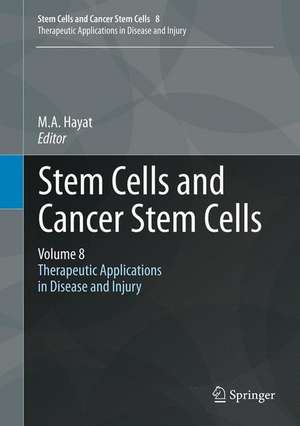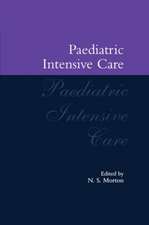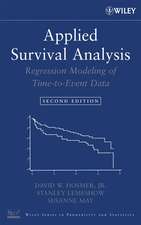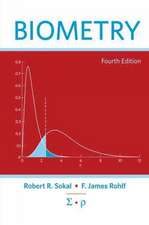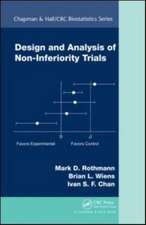Stem Cells and Cancer Stem Cells, Volume 8: Therapeutic Applications in Disease and Injury: Stem Cells and Cancer Stem Cells, cartea 8
Editat de M.A. Hayaten Limba Engleză Hardback – 9 oct 2012
| Toate formatele și edițiile | Preț | Express |
|---|---|---|
| Paperback (1) | 997.11 lei 38-44 zile | |
| SPRINGER NETHERLANDS – 23 aug 2016 | 997.11 lei 38-44 zile | |
| Hardback (1) | 1124.07 lei 6-8 săpt. | |
| SPRINGER NETHERLANDS – 9 oct 2012 | 1124.07 lei 6-8 săpt. |
Preț: 1124.07 lei
Preț vechi: 1183.22 lei
-5% Nou
Puncte Express: 1686
Preț estimativ în valută:
215.16€ • 233.79$ • 180.85£
215.16€ • 233.79$ • 180.85£
Carte tipărită la comandă
Livrare economică 21 aprilie-05 mai
Preluare comenzi: 021 569.72.76
Specificații
ISBN-13: 9789400747975
ISBN-10: 9400747977
Pagini: 300
Ilustrații: XLVII, 364 p.
Dimensiuni: 178 x 254 x 23 mm
Greutate: 1.16 kg
Ediția:2012
Editura: SPRINGER NETHERLANDS
Colecția Springer
Seria Stem Cells and Cancer Stem Cells
Locul publicării:Dordrecht, Netherlands
ISBN-10: 9400747977
Pagini: 300
Ilustrații: XLVII, 364 p.
Dimensiuni: 178 x 254 x 23 mm
Greutate: 1.16 kg
Ediția:2012
Editura: SPRINGER NETHERLANDS
Colecția Springer
Seria Stem Cells and Cancer Stem Cells
Locul publicării:Dordrecht, Netherlands
Public țintă
GraduateCuprins
Preface. I. Stem cell culture.-1 Stem cell culture: optimizing amidst the complexity.-2 Development of defined culture conditions for expansion of human mesenchymal stromal cells for clinical applications.-3 Retention of stem cell properties post-expansion in myosphere culture.II. Bone marrow stem cells.-4Role of reactive oxygen species formation form oxidized low density lipoprotein in bone marrow stem cells.-5 The role of bone marrow-derived progenitor cells in tumor growth and angiogenesis.-6 Myelodysplastic stem cells: gene expression profiling.III. Mesenchymal stem cells.-7Human mesenchymal stem cell transdifferentiation to neural cells: role of tumor necrosis factor alpha.-8 Role of mesenchymal stem cells (msc) in hiv-1 associated bone and lipid toxicities.-9 Mesenchymal stem cell therapy: immunomodulation and homing mechanisms.-10 Mesenchymal stem cells: the role of endothelial cells and the vasculature.-11 Use of cancer/testis antigens in immunotherapy: potential effect on mesenchymal stem cells.IV. Reprogramming and differentiation of stem cells.-12 Regulation of self-renewal and pluripotency of embryonic stem cells: role of natriuretic peptide receptor.-13 Reprogramming and pluripotency of epiblast stem cells.-14Epigenetic modifiers and stem cell differentiation.-15 Enrichment and selection of stem cell-derived tissue-specific precursors.-16 Differentiation of pluripotent stem cells into steroidogenic cells: role of sf-1 regulator.-17 Human embryonic stem cell differentiation: role of glycosphingolipid structure.-18 Differentiation of human embryonic stem cells into pancreatic endocrine cells.-19 ransformation of vascular endothelial cells into multipotent stem-like cells: role of the activin-like kinase 2 receptor.V. Treatment.-20 Colon cancer stem cells: a therapeutic target.-21 Treatment of damaged brain following a stroke: new strategies.-22 Parthenogenetic activation-induced pluripotent stem cells and potential applications.-23 Neuroprotection forstroke using glial cell line-derived neurotrophic factor/neural stem cells grafting.-24Derivation of germ cells from pluripotent stem cells: prospects and applications.-25 Purinergic receptors in stem cell biology.-26 Cancer stem cells of the head and neck.-27 Functional restoration of salivary glands after radiotherapy: roles of wnt and hedgehog pathways.-28 Neural stem cell migration: role of directional cues and electric fields.-29 Abl-kinase mutations in progenitors and stem cells from chronic myeloid leukemia patients.VI. Transplantation.-30 Treatment for erectile dysfunction after radical prostatectomy: transplantation of stem/progenitor cells.-31 Collection of peripheral blood stem cells from healthy family and unrelated donors for haematopoietic stem cell transplantation.-32 Effects of smoking on the outcomes of cancer patients after hematopoietic stem cell transplantation.-33 Ex vivo expansion of stem and progenitor cells using thrombopoietin.Index.
Textul de pe ultima copertă
This eighth volume in the essential Springer series of cutting-edge contributions in stem cell and cancer stem cell research features the work of 85 authors based in more than a dozen nations. It provides scientists in this vital field with the latest data and techniques, enhancing our knowledge base of the causes, diagnosis, and cell-based treatment of major human diseases including cancer, as well as therapies targeting debilitating injuries to human tissue and organs. The volume’s six sections are arranged thematically, covering stem cell culture, bone marrow stem cells, mesenchymal stem cells, the reprogramming and differentiation of stem cells, treatments, and transplantation.
The information has been submitted by a range of experts working at the leading edge of the field, including oncologists, neurosurgeons, physicians, research scientists and pathologists. They cover a formidable array of topics and offer differing scientific perspectives on specific, and in some cases highly controversial, aspects of cancer treatment and tissue regeneration. The section on stem cell culture includes information on developing defined culture conditions for expanding mesenchymal stromal cells in preparation for clinical applications. The importance of optimization of culture conditions and conservation of natural three-dimensional cell shape and morphology is pointed out because they are critical factors in maintaining cell phenotype and controlling differentiation. Regarding bone marrow stem cells, researchers share data on the gene expression profiling of myelodysplastic stem cells; the section on reprogramming and differentiation features the latest research focusing on epigenetic modifiers. This essential volume, like its companions in the series, is required reading for academics and physicians who need with keep up to the speed in a fast-developing field with unrivalledpotential for overcoming some of mankind’s most intractable and devastating pathologies.
The information has been submitted by a range of experts working at the leading edge of the field, including oncologists, neurosurgeons, physicians, research scientists and pathologists. They cover a formidable array of topics and offer differing scientific perspectives on specific, and in some cases highly controversial, aspects of cancer treatment and tissue regeneration. The section on stem cell culture includes information on developing defined culture conditions for expanding mesenchymal stromal cells in preparation for clinical applications. The importance of optimization of culture conditions and conservation of natural three-dimensional cell shape and morphology is pointed out because they are critical factors in maintaining cell phenotype and controlling differentiation. Regarding bone marrow stem cells, researchers share data on the gene expression profiling of myelodysplastic stem cells; the section on reprogramming and differentiation features the latest research focusing on epigenetic modifiers. This essential volume, like its companions in the series, is required reading for academics and physicians who need with keep up to the speed in a fast-developing field with unrivalledpotential for overcoming some of mankind’s most intractable and devastating pathologies.
Caracteristici
This volume was written by 85 contributors representing 14 countries The advantage of involving more than one author is to present different points of view on a specific controversial aspect of cancer cure and tissue regeneration This volume assists readers with a more complete understanding of the causes, diagnosis, and cell-based treatment of major human diseases and debilitating tissue/organ injuries The contents of the volume are divided into six subheadings for the convenience of the readers.
